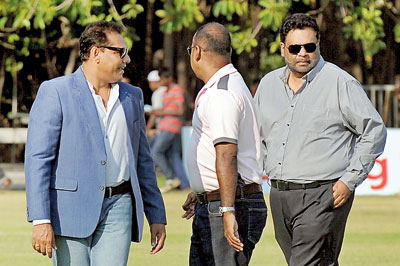SLRFU back in the saddle with old and new faces

Asanga Seneviratne is back in the saddle as head of SLRFU - Pic by Amila Gamage
The Council of the Sri Lanka Rugby Football Union (SLRFU) is back in swing and had its council meeting on Thursday, March 31. Previously a meeting was called for April 8 to hold an election for office bearers. As there was no contest for posts the Sunday Times learns that the Ministry of Sports through the Competent Authority for rugby deemed that there is no need for an election and declared that the council as elected. However there is a possibility that an Annual General Meeting will be held on another date to complete other matters that are required such as presentation of accounts.
The SLRFU is headed by Asanga Seneviratne with a few old faces and some new ones joining the council as they move forward. Lasitha Gunratne retains the post of Vice President the Secretary will be rugby veteran Nazim Mohamed.
Meanwhile the Schools Rugby Football Association is scheduled to have their Annual General Meeting on Sunday, April 3. They too have reached consensus to avoid an election and B.A. Abeyratne, the Principal of Royal College will be President and Denzel Darling is expected to be the Secretary.
The development of rugby in Sri Lanka is dependent on these two arms that govern the game of rugby in Sri Lanka. The SLRFU is the governing body while SLSRFA control schools where the cradle of rugby is. For a start to see both wings electing the office bearers by consensus is good for the game. The need that is more important is for these two arms of rugby to work together for the development of the game. The long term player development starts with school rugby. Schools have their own code directed by the Education Ministry when it comes to schoolboy participation in sports. That should be used as a spring board to rugby development and not considered as a hurdle or as our right, as interpreted by each party, resulting in a tug of war.
In India there is a lot of work to spread rugby and uses what World Rugby promotes as Get into Rugby. I was told that when the odd shaped ball is introduced there seem to be interest as the ball looks odd. That it draws interest despite the fact that most will not know what game is played with that ball. This is despite that Kolkata can be linked to the England vs. Scotland match for the Calcutta Cup played in 1870s and still played annually though not in India. Yet it appears as seen by be me during a recent visit on rugby to Chennai India is in the process of strengthening the infrastructure for spreading rugby. The numbers of World Rugby licensed Educators are increasing thereby swelling the numbers of coaches, referee etc. that will be required at the grass root level.
A major problem they face is the lack of sponsors as the game is not popular and till recently linked to a small sort of closed sect. Yet in recent times the game is spreading form being centered around two clubs in Kolkata and Mumbai.
Noomi Mehta, president of the Indian Rugby Football Board says rugby could learn from the success of cricket’s Indian Premier League – creating a made-for-television short format tournament with Bollywood owners, music, and razzmatazz that attracts international players by making it financially worth their while.
In contrast to the game and its problems of spreading in India, Sri Lanka has a population most of whom will recognise the oval ball and know what is played with it. It has a structure and there seem to be no hardship in finding sponsors. It has a base in the schools and the game is spreading. There is support for the game by the education authorities and the parents and is a rich source of feed where clubs have little involvement in developing youth rugby. Then it is sine qua non for the game to go forward; for the Governing Body and the school section to work in developing and spreading the game. The important requirement is to spread the game through the school for which you need the approval of the institution which will adhere to directives of the Ministry of Education. The easy way through is the Schools Section for Rugby.
In the past three weeks I have seen a few school matches of the lower division tournament. There is a yawning gap between the Division 1 Segment A and those in Segment 2, and Division 2. Speaking to some of the Masters-in-Charge and Principals of these schools to ask why the standards are dropping, they complained of their inability to retain players who are poached by the top schools. They also cannot afford the money the big schools have. This they believe is hindering the continuance as well as leading to frustration of coaches who do not want to continue as they lose the players they train with difficulty. The game and the ball is known but factors that is in conflict seem to growing by the day.
* Vimal Perera is a former player, coach, referee and an IRB Accredited Referees’ Educator


